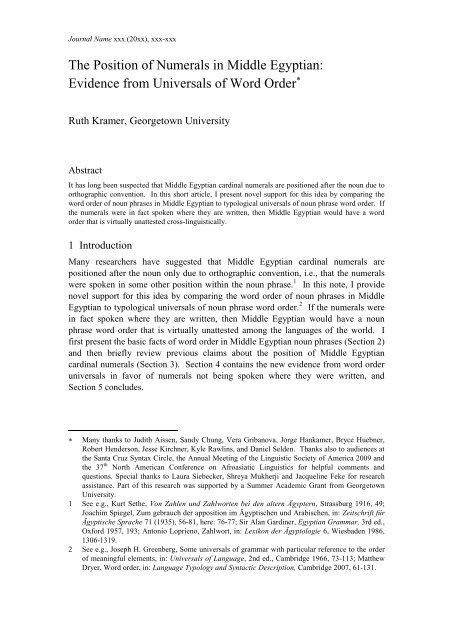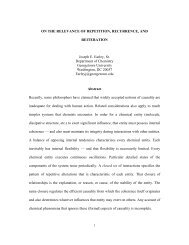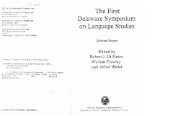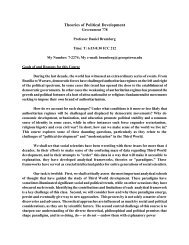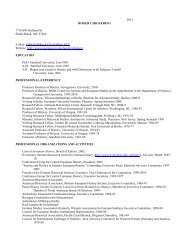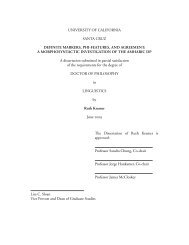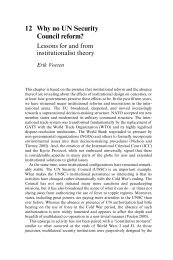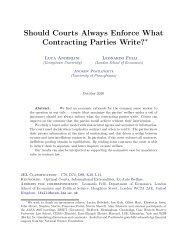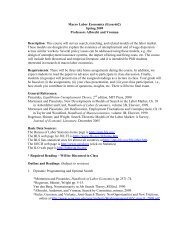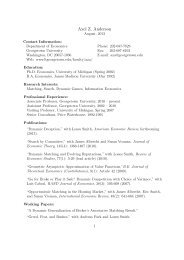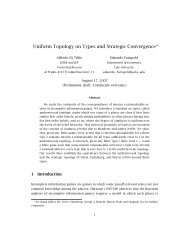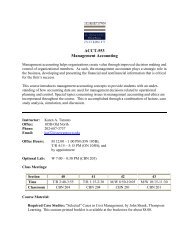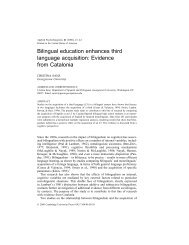The Position of Numerals in Middle Egyptian - Georgetown University
The Position of Numerals in Middle Egyptian - Georgetown University
The Position of Numerals in Middle Egyptian - Georgetown University
- No tags were found...
You also want an ePaper? Increase the reach of your titles
YUMPU automatically turns print PDFs into web optimized ePapers that Google loves.
<strong>Numerals</strong> and Word Order 5Of course, typology has progressed beyond Greenberg’s sem<strong>in</strong>al work and moreand more languages have had their word orders recorded. Prenom<strong>in</strong>ally, the order[Dem Num A] is still essentially considered to be correct. 14 Postnom<strong>in</strong>ally, though, ithas been claimed that there is vast variation to the po<strong>in</strong>t <strong>of</strong> any order perhaps be<strong>in</strong>gpermissible. 15However, there have been several large-scale typological <strong>in</strong>vestigations where allthe possible comb<strong>in</strong>ations <strong>of</strong> noun, demonstrative, adjective and numeral have beenconsidered. 16 In those, no language has been found with the order [N Num DemA]. 17 Rather than <strong>Middle</strong> <strong>Egyptian</strong> be<strong>in</strong>g the only language ever spoken with thisword order, it seems more plausible that the ‘actual’ (i.e., spoken) order was not thewritten order. 18Results from typological research, then, support the idea that there is someth<strong>in</strong>g<strong>of</strong>f about the word order <strong>in</strong> noun phrases <strong>in</strong> <strong>Middle</strong> <strong>Egyptian</strong>. <strong>The</strong> typological factsalone do not p<strong>in</strong>po<strong>in</strong>t the numeral as responsible for the problem, but they stronglysuggest that the order cannot be as written.I conclude by address<strong>in</strong>g a potential confound. <strong>The</strong>re is one language which hasbeen claimed to have [N Num Dem A] word order: Haya, a Bantu (Niger-Congo)language spoken <strong>in</strong> Tanzania. 19 However, <strong>in</strong> the only published data on noun phraseword order, 20 the ‚adjectives‘ do not have the category adjective but are <strong>in</strong> factrelative clauses (e.g., they conta<strong>in</strong> a relative pronom<strong>in</strong>al prefix). Could adjectives <strong>in</strong><strong>Middle</strong> <strong>Egyptian</strong> also be relative clauses?At first, it seems plausible that the answer is yes. As is well known, many (if notmost) adjectives <strong>in</strong> <strong>Middle</strong> <strong>Egyptian</strong> are, strictly speak<strong>in</strong>g, participles derived fromadjectival verbs and can be <strong>in</strong>terpreted as relative clauses. 21 For example, (3)a can betranslated literally as ‚that god who is beneficent.‘ However, there is a subset <strong>of</strong>14 See e.g, John Hawk<strong>in</strong>s, Word Order Universals, New York 1983; B<strong>in</strong>gfu Lu, Left-rightasymmetries <strong>of</strong> word order variation: a functional explanation, unpublished doctoral dissertation,<strong>University</strong> <strong>of</strong> Southern California (1998); William Cr<strong>of</strong>t and Efros<strong>in</strong>i Deligianni, Asymmetries <strong>in</strong>NP word order, unpublished manuscript, <strong>University</strong> <strong>of</strong> Manchester (2001). See also for possibleexceptions: Guglielmo C<strong>in</strong>que, Deriv<strong>in</strong>g Greenberg’s Universal 20 and its exceptions, L<strong>in</strong>guisticInquiry 36 (2005), 315-322, here: 315, fn.2.15 See e.g., Hawk<strong>in</strong>s, Word Order Universals, and Cr<strong>of</strong>t and Deligianni, unpub. ms. (2001).16 Lu, unpub. doctoral dissertation (1998); C<strong>in</strong>que, <strong>in</strong>: L<strong>in</strong>guistic Inquiry, 2005. See also JanRijkh<strong>of</strong>f, <strong>The</strong> Noun Phrase, Oxford 2002.17 This order was also not found <strong>in</strong> Cr<strong>of</strong>t and Deligianni unpub. ms. (2001), perhaps provid<strong>in</strong>g theexception to their claim that “virtually” every order can be found post-nom<strong>in</strong>ally.18 One recent paper (Michael Cysouw, Deal<strong>in</strong>g with diversity: towards an explanation <strong>of</strong> NP-<strong>in</strong>ternalword order frequencies, <strong>in</strong>: L<strong>in</strong>guistic Typology 14 (2010), 253-286) argues that word orders areneither attested nor unattested, but are simply more or less likely to occur accord<strong>in</strong>g to a model.Regardless <strong>of</strong> whether one adopts this approach or a more conventional approach, it hasuniversally been found that there is a zero or extremely low frequency <strong>of</strong> [N Num Dem A].<strong>Middle</strong> <strong>Egyptian</strong> has an order that is either unattested <strong>in</strong> any language (<strong>in</strong> the conventional view)or which has an extremely low probability, both <strong>of</strong> which support the claim that the numerals arenot <strong>in</strong> their ‘actual’ position.19 This is the language referred to <strong>in</strong> Cysouw, <strong>in</strong>: L<strong>in</strong>guistic Typology 14 (2010), 284. See ErnestRugwa Byarushengo, Alessandro Duranti and Larry M. Hyman, Haya Grammatical Structure, LosAngeles 1977, for grammatical description.20 Byarushengo, Duranti and Hyman, Haya Grammatical Structure, 13.21 See e.g., Loprieno, Ancient <strong>Egyptian</strong>, 87.
<strong>Numerals</strong> and Word Order 6adjectives <strong>in</strong> <strong>Middle</strong> <strong>Egyptian</strong> that are not derived from verbs, most notably, thenisba-adjectives. 22 <strong>The</strong> nisba-adjectives are true adjectives derived from nouns orprepositions. 23 If a nisba adjective can be ordered after a demonstrative, then we havemore secure pro<strong>of</strong> that the word order <strong>of</strong> <strong>Middle</strong> <strong>Egyptian</strong> is [N Num Dem A].This is <strong>in</strong> fact the case: nisbas come last <strong>in</strong> the noun phrase. One <strong>of</strong> the mostcommon nisba adjectives is the so-called genitival nj‚ mean<strong>in</strong>g ‚<strong>of</strong>, belong<strong>in</strong>g to‘.<strong>The</strong>re are a few examples <strong>of</strong> genitival nj <strong>in</strong> the same noun phrase as a demonstrative,and it follows the demonstrative. In (12), the nisba nj follows the demonstrative pn.(12) Hq# pn nj rTnw ‚this leader <strong>of</strong> Retjenu’ (S<strong>in</strong>. B 99-100)Thus, I conclude that adjectives truly were the f<strong>in</strong>al component <strong>of</strong> the noun phrase <strong>in</strong><strong>Middle</strong> <strong>Egyptian</strong>, and the confound is removed.5 ConclusionIn sum, word order universals support the claim that <strong>Middle</strong> <strong>Egyptian</strong> numerals werepronounced <strong>in</strong> a different position than where they were written. Up to this po<strong>in</strong>t,universals <strong>of</strong> word order have played little to no role <strong>in</strong> research on <strong>Middle</strong> <strong>Egyptian</strong>syntax, 24 and hopefully these typological tools will prove to be useful <strong>in</strong> address<strong>in</strong>g arange <strong>of</strong> questions relevant to <strong>Egyptian</strong> l<strong>in</strong>guistics.22 <strong>The</strong> ‚true‘ adjectival nature <strong>of</strong> the nisbas was orig<strong>in</strong>ally noted by Gard<strong>in</strong>er, <strong>Egyptian</strong> Grammar,108, n.1a.23 See e.g., Loprieno, Ancient <strong>Egyptian</strong>, 100 as well as Helmut Satz<strong>in</strong>ger, Syntax derPräpositionsadjektive, <strong>in</strong>: Zeitschrift für Ägyptische Sprache 113 (1986), 141-153; Karl Jansen-W<strong>in</strong>keln, Nisbeadjektiv und Partizip, <strong>in</strong>: L<strong>in</strong>gua Aegyptia 3 (1993), 7-16.24 <strong>The</strong>re are a handful <strong>of</strong> papers on syntactic typology that do not discuss word order universals (seee.g., Antonio Loprieno, Towards a typology <strong>of</strong> <strong>Middle</strong> <strong>Egyptian</strong>, <strong>in</strong>: Proceed<strong>in</strong>gs <strong>of</strong> the FifthInternational Hamito-Semitic Congress, Vol. 2, Vienna 1991, 107-119; Frank Kammerzell,<strong>Egyptian</strong> possessive constructions: a diachronic typological perspective, <strong>in</strong>: Sprachtypologie undUniversalienforschung 53/I (2000), 97-108), and Frank Kammerzell has a comment <strong>in</strong> the onl<strong>in</strong>eUniversals Archive (http://typo.uni-konstanz.de/archive/<strong>in</strong>tro/) that Old <strong>Egyptian</strong> is not anexception to Universal 20 s<strong>in</strong>ce its prenom<strong>in</strong>al numerals were <strong>in</strong> fact nouns. However, I know <strong>of</strong>no research that <strong>in</strong>vestigates <strong>Egyptian</strong> specifically with respect to universals <strong>of</strong> word order.


